Menu
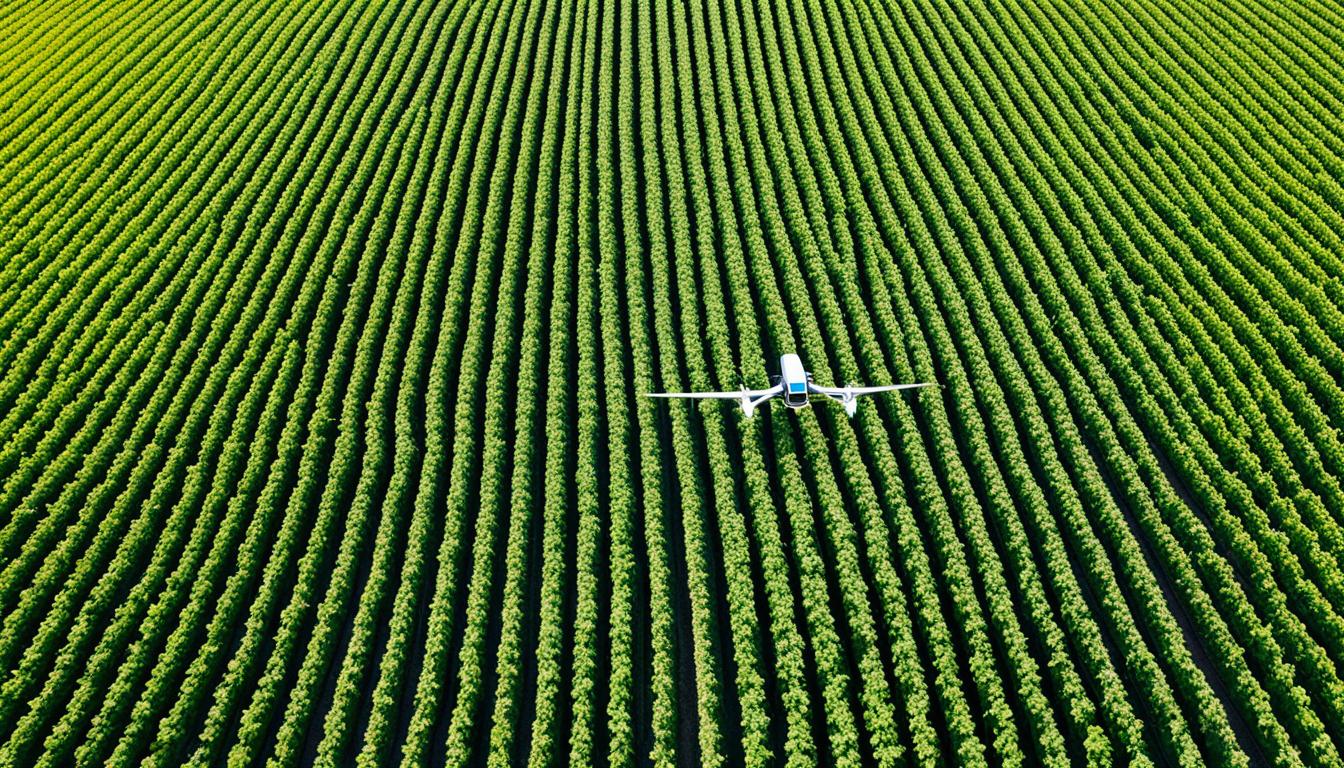
As of 2023, just 27% of U.S. farms or ranches were using precision agriculture methods. This number, from the U.S. Department of Agriculture, shows great room for growth in farming. Despite large investments in research, many farms have not yet taken up this tech.
Precision agriculture can make farms more efficient and increase yields. It does this by using resources better. Mobile tech is a big part of this, letting farmers access data in real-time and make smart choices from a distance.
Mobile tech has changed the farming game, moving it toward digital solutions. Now, every farming choice can be backed by data. This means farms can be more efficient and save resources. By using mobile tech, farmers can get better at farming, leading to more sustainable growth and bigger harvests.
Precision agriculture uses cutting-edge tools to observe and adjust to field differences. It aims to boost environmental care, farm sustainability, and yield. Smart agriculture benefits include better control of water, fertilisers, and pesticides.
For example, in Missouri, GPS signals are accurate to about 300 feet normally. But, with correction, accuracy jumps to 6 to 10 feet. This means farmers can use resources better. The Coast Guard also helps by correcting GPS for free.
Grid soil sampling is another key digital farming benefit. It suggests taking 10 samples for a 20-acre area with a 2-acre grid. This gives detailed soil nutrient information to guide farming decisions.
Moreover, Geographic Information Systems (GIS) organise vast data, like crop yields and soil maps. Farmers can use this to test different ways of managing their land, offering precision farming advantage.
Remote data is crucial for spotting crop stress and using chemicals correctly. During scouting, farmers can check for weeds, bugs, or low nutrient areas. This method helps in better farming that’s both green and efficient.
| Technology | Advantages |
|---|---|
| Precision GPS | Enhanced accuracy from 300 feet to 6-10 feet |
| Grid Soil Sampling | Detailed nutrient level assessment |
| GIS | Integration of multiple data layers for better decision making |
| Remotely-Sensed Data | Optimises use of agricultural chemicals |
Precision farming helps in many ways. It cuts costs, maintains soil, and doesn’t rely too much on weather. This method ensures that crops grow their best. It improves both farm profit and the environment with help from drones, satellites, and GPS.
Agricultural technology is changing how we farm, providing many benefits. One key area is precision agriculture, growing rapidly. Its market hit USD 9.4 billion in 2022 and is set to keep rising. By 2030, experts expect it to be a CAGR of 12.6%.
This growth is due to new farming tech like GPS, sensors, drones, AI, and robots. These breakthroughs are improving how farms run, making them more efficient and green. Places like North America and Europe are using this tech a lot. They see big improvements in crops like corn, soybeans, and wheat. This tech is also helping with fruits and vegetables.
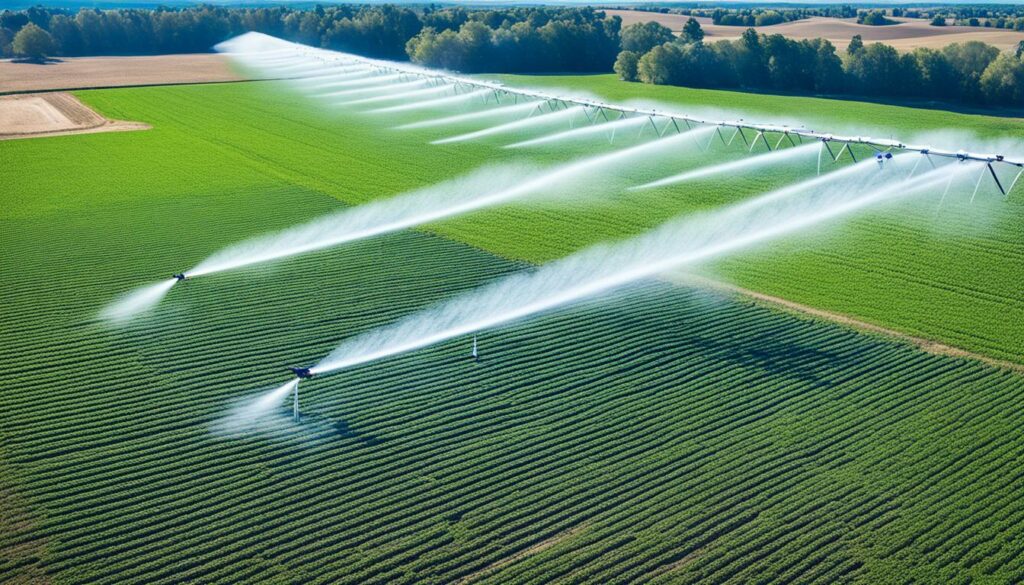
But, not everyone is quickly adopting this tech. This is because it costs a lot, is complex, and needs careful data handling. To help more people use it, experts suggest things like lowering costs, simpler tech, and better training.
Looking ahead, precision agriculture will merge more with AI and IoT. It will use more self-driving farming machines and focus on personalised farming. The aim is to go green, with help from new policies. Big companies are working together on exciting projects. For instance, Guardian Agriculture’s SC1 eVTOL drone is changing how we manage crops from the sky.
Partnerships between firms like Intelinair and Hubner Industries are boosting seed production. They use high-tech images and data to make better seeds. Others like Croptimistic Technology Inc. are simplifying farm work with smart tools. And, robots are getting more involved, like the ones from Organifarms and 4AG Robotics for different tasks. These developments show how much technology can improve farming.
The benefits of agricultural tech are huge. It shows how important technology is in agriculture. As we see more developments, we’re heading towards a future where farming is more efficient and green. But, to get there, we need to make sure everyone in farming can access and use this tech. It’s key for a better farming future for us all.
Mobile technology is now key in precision agriculture, offering many benefits. It boosts productivity and efficiency. Through mobile farming apps, farmers get instant access to vital data. This helps them make quick, smart decisions.
Farmers can now get real-time farm data on their phones. They can check things like soil moisture, weather, and crop health at any time. This quick view lets them react fast to any problems. They’re using resources better, cutting waste, and boosting their harvests.
Thanks to mobile tech, farmers can now manage their farms from afar. They can watch over irrigation and change settings without being on site. This saves both water and work. It boosts the farm’s output and saves a lot of resources.
No more bulky paper logs. Thanks to mobile apps, keeping records is easy. Farmers can store, update, and look at their data with no trouble. This change makes managing the farm smoother, from planting to meeting rules.
Good communication is vital in today’s agriculture. Mobile tech supports quick talks among farmers. They can share tips or solve problems fast. This makes the farm run better and more effectively.
Recently, a workshop with 187 attendees from universities, such as Iowa State (51%) and North Carolina A&T (27%), talked about digital farming’s future. It shows how committed they are to making farming better with mobile tech.
| University | Percentage |
|---|---|
| Iowa State University | 51% |
| North Carolina A&T State University | 27% |
| Penn State University | 4% |
| University of Illinois | 5% |
| University of California, Merced | 3% |
| University of Arizona | 2% |
| Others | 8% |
Precision agriculture is changing the game for farmers today. It helps them make smarter choices and use resources better. Even though only a quarter of U.S. farms use these methods so far, the benefits are big. The USDA and the National Science Foundation have put over $200 million into this tech from 2017 to 2021.
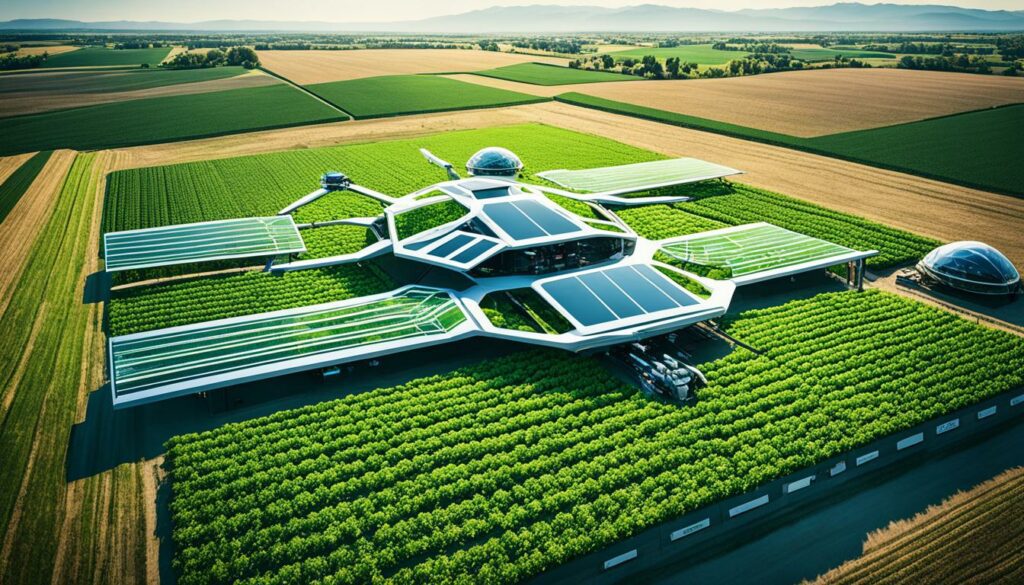
So, why is precision agriculture so great? Well, it boosts crop growth by 4% and makes fertiliser use 7% more efficient. This means farmers get more from their land while using less. They also cut back on harmful chemicals by 9%, save fossil fuels by 6%, and decrease water use by 4%. These small changes add up to farming that’s kinder to the environment.
But the benefits go beyond the field. Thanks to precision ag, farmers have saved on their lands, with 2 million acres conserved. This reduced herbicide use by 30 million pounds. Plus, these methods save a huge amount of water and fossil fuels. This is a big win for the planet.
Still, there are hurdles to jump for more farms to join in. The steep upfront costs and worries about sharing data and rules hold some farmers back. But, with the right support, this can change. Giving financial help, clearer benefits, more info, and pushing for innovation can make precision agriculture more popular.
Looking ahead, if everyone adopts precision agriculture, we could see some incredible changes. Like a 6% bump in how much food we grow, and a 14% savings in fertiliser. There would be 48 million pounds fewer herbicides and pesticides used. Also, a 21% cut in water and a 16% fall in fossil fuel use are possible. Plus, this could stop 17.3 million metric tons of CO2 from polluting the air.
All in all, precision farming is good for the farm, the earth, and our wallets. With more help and new ideas, the farming of tomorrow could be incredible. Let’s work towards bringing these big benefits to all farms in the U.S.:
Mobile technology is changing the game for precision agriculture and sustainable farming. It lets farmers check data instantly. This helps them make better choices and allows farms to grow smarter, faster.
With mobile tech, farmers can quickly learn about crops, soil, and the weather. They can then make decisions fast. This boosts how well precision farming works. Using data, farms can grow more crops and waste less, all while managing resources better.
Mobile tech also saves farmers time and money. Smart farming tools mean they only use water, fertiliser, and pesticides where it’s needed. This not only saves resources but also cuts costs, making farming more affordable.
Going mobile helps farming be more green. It cuts down on water, fertiliser, and pesticide use, which is better for the planet. This way, farming not only gets smarter but also kinder to the Earth. Real-time data makes these green efforts even more effective.
Another big plus of mobile tech in farming? Scalability and flexibility. It works for all farms, whether small or huge. Mobile apps can be custom to suit any farm needs. This makes it easy for farms to get better and adjust quickly to any changes.
Look at all the big wins in the table below:
| Aspect | Benefits |
|---|---|
| Decision-Making | Real-time data, informed choices, increased yields |
| Cost Savings | Reduced use of inputs, lower operating costs |
| Sustainability | Reduced environmental impact, efficient resource use |
| Scalability | Adaptable to various farm sizes, flexible operations |
Mobile technology is pushing precision farming forward. It saves money, helps the planet, and makes farming future-proof. By leveraging mobile tools, the future of farming is bright with new ways to grow more efficiently and sustainably.
Precision agriculture offers many benefits. Yet, it faces big hurdles in becoming widely used. Only 27 percent of U.S. farms used it from 2022 to 2023. This shows there are several obstacles to overcome.
The first challenge is the significant cost to start. This includes advanced machinery, sensors, and software. A study found that 60 percent of producers are held back by these costs. They’re not just about buying the equipment. The ongoing costs for software and maintenance are also a concern.
Data privacy is another issue. Farmers are worried about who owns and secures the data from these systems. This worry, and the confusion about sharing and owning data, slows down its use.
“A lack of standards for interoperability between different technologies further exacerbates these challenges,”
This quote shows the need for systems that can work together easily. Without this, it’s hard for farmers to use these new technologies.
Farm size, age, and education also play a role in how hard these challenges feel. Smaller farms and older farmers might find it harder to invest. They are more worried about costs and less used to digital tools. Yet, big farms and younger, more educated farmers are keener on new technologies.
Finding the best zones for input use is also tricky. There’s not enough research to guide farmers well. This makes it tough for farms to use these tools effectively.
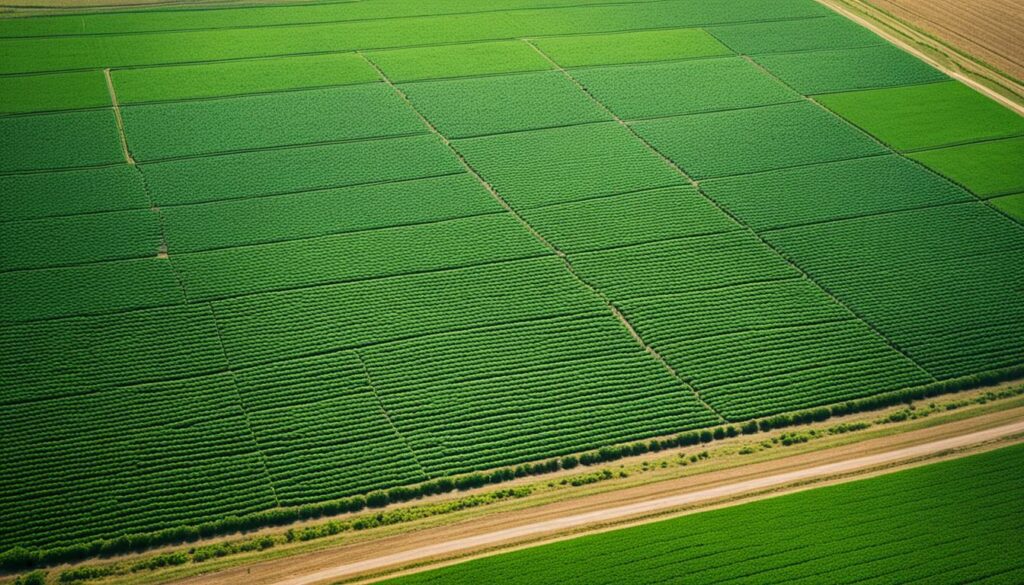
Even with a lot of research funding, precision agriculture isn’t spreading fast. This is why strong policies are needed. These should include money help, promoting new ideas, and setting clear data rules.
| Factor | Challenge | Impact |
|---|---|---|
| Cost | High initial and ongoing expenses | Limits widespread adoption |
| Data Privacy | Concerns over data security and ownership | Hinders data sharing and utilisation |
| Technology Compatibility | Interoperability issues | Complicates integration of different systems |
| Knowledge and Familiarity | Varies with farm size, age, and education | Affects willingness to adopt new technologies |
| Research and Demonstration | Limited conclusive research on input management zones | Challenges optimisation and profitability |
Precision agriculture combines smart farming with high-tech solutions. It aims to save natural resources and boost farming efficiency. By using precision methods, farmers can win big for the environment. This means farming can stay strong and eco-friendly for years to come.
One big win for precision farming is how it manages water better. For example, tech like variable rate irrigation has cut water use by 4%. This also saved enough water to fill around 750,000 Olympic pools. Cutting water needs by another 21% shows just how powerful precision methods are in farming.
Precision farming is also great for the planet by using less fuel. It’s cut fossil fuel use by 6%, which means 100 million fewer gallons burnt. This has dropped CO2 emissions by 10.1 million tons. Plus, spreading these practices further could save another 17.3 million tons of CO2 from entering the air.
One major plus of precision farming is that it lowers chemical use. There’s been a 9% decrease in pesticides and herbicides. This means 30 million fewer pounds of chemicals are harming the environment. By applying chemicals with precision, farmers also cut back an additional 48 million pounds. These practices really help keep our soils and waters clean.
In precision agriculture, sensors and drones play a huge role. They gather detailed data about crop health and soil. This information helps farmers manage their farms better.
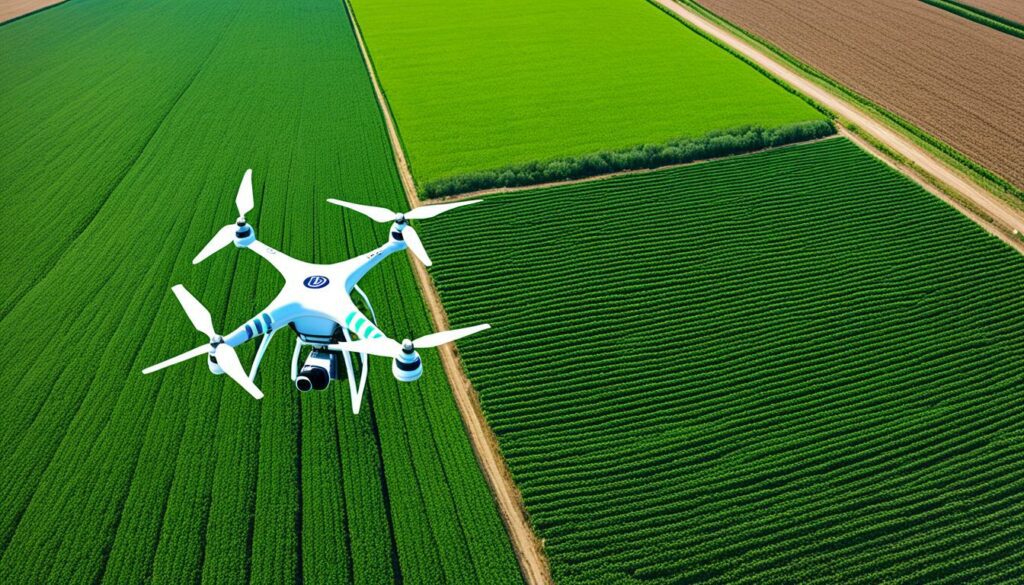
Drones provide close-up pictures of crops for health checks. They take images in real-time. This quick access to field data lets farmers act fast to protect their plants.
Using drones, farmers can be very precise with their fertilisers and pesticides. This saves money and helps the environment. Less waste means better farming for the future.
Drones can help with big challenges in farming quickly. They cover a lot of ground fast, which is great for checking on growing crops. This shows why drones are becoming so important in agriculture.
The agricultural drone market is growing rapidly. By 2025, it could reach $6 billion. Drones are becoming smarter, making farming more efficient and sustainable.
Still, using drones and sensors in farming has its challenges. It can be expensive and complex. But the benefits in the long run are clear. They are key to profitable and eco-friendly farming in the future.
Precision farming brings big financial advantages, saving costs in agriculture and ensuring farms make a profit over time. In 2023, only 27 percent of U.S. farms used precision farming. However, those that did saw big cuts in the cost of things needed for crops, like fertiliser and herbicides.
Systems like GPS, drones, and satellite imagery help farmers use their land more effectively. This means they can spend less on things like fertiliser and still grow the same amount. It’s a smart way to farm, saving money all around.
The U.S. is investing heavily in precision farming, putting nearly $200 million into it between 2017 and 2021. These big investments in the technology point to its potential to make farms more profitable.
| Precision Technology | Cost Savings Per Acre | Operational Profit Increase |
|---|---|---|
| Yield Mapping with GPS | $25 | 3% |
| VRT with Yield Mapping | $22 | 1.1% |
| Guidance Systems | $15 | 2.5% |
Yield mapping can save corn farmers over $25 for each acre. Guidance systems save around $15 per acre, but with VRT, savings and efficiency are even better. This shows how useful precision farming can be.
Precision farming stops waste by making sure resources are used where they’re needed. Although it needs some initial investment, the savings on costs and the increased yields are well worth it. This makes precision farming a good deal for today’s farmers.
As precision farming becomes the norm on more farms, the tech and methods will only get better. This could make it easier for more farmers to get on board and enjoy the big financial rewards. With more research, precision farming looks to have a bright future in farming.
Precision agriculture is changing farming by making it more productive. It uses data to understand soil and crop needs. This helps farmers grow more crops without using more resources.
Currently, only 27% of U.S. farms use precision agriculture. There’s a big chance to increase productivity by using these methods more. With a lot of funding for research, the farming future looks bright.
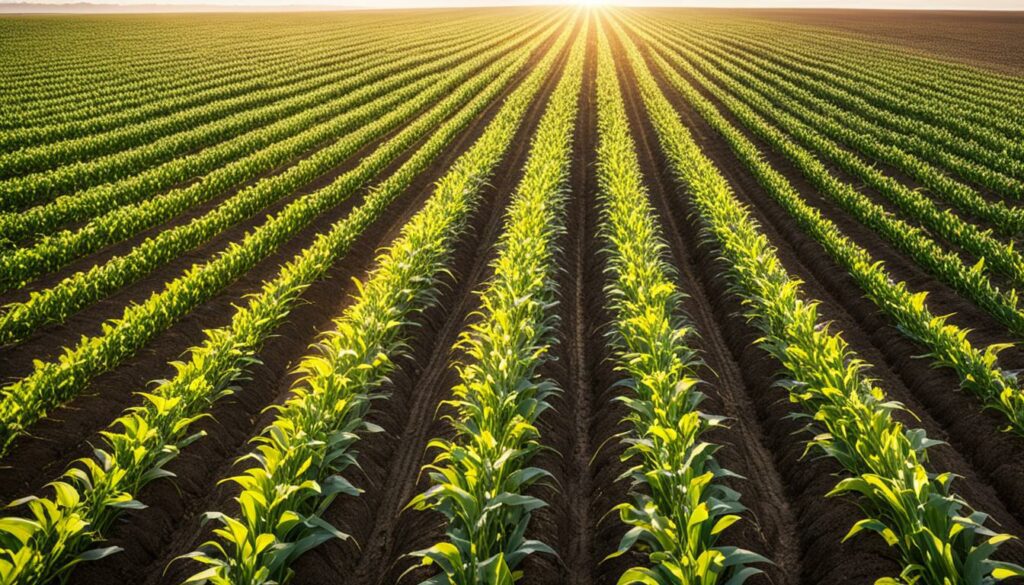
These farming techs can make more money for farmers. They can either grow more with the same effort or grow the same with less. For example, soil sensors help save water, tackling shortages and saving the environment.
They also cut down on things like fertiliser, which is good for the earth. Smart data analysis helps farmers choose better, making farms more efficient. This kind of farming is called precision agriculture.
But, getting all this new tech can be expensive at first. It’s important that governments and others help afford it. They should encourage using new methods that make farming better for everyone.
The good things about precision agriculture are hard to ignore. It can boost productivity by 6% and save a lot of water. New ways of farming offer a way forward to better crop yields and a more productive farm sector.
The precision agriculture market hit USD 9.4 billion in 2022. By 2030, it’s expected to grow by 12.6% each year. This growth shows how important innovation is for the sector’s progress. Precision agriculture innovations are vital for the future of farming. They include AI, IoT, and robotics. Let’s explore the latest trends in precision agriculture.
Future farming is all about machine autonomy. It involves using robotics and AI for planting, weeding, and harvesting. This shift cuts labour costs and improves the accuracy of farming tasks. Machines with AI applications work non-stop. This ensures farming is consistent and highly efficient.
The Internet of Things (IoT) connects farm operations. It links devices like sensors, drones, and GPS. This connection helps farmers get real-time data on crops, soil, and the environment. It’s essential for precision agriculture innovations. Plus, it aids sustainable farming. For example, smart irrigation systems save water and increase crop yields.
Data analytics and predictive modelling are changing how decisions are made in farming. AI analyses big data to offer useful insights. For example, it can predict crop yields or spot pest risks. This use of tech helps farms make smarter choices. It boosts efficiency and productivity. Using AI in farming means you can be ready for any challenge.
GPS is key to precise positioning solutions. It helps with accurate navigation and farming in specific areas. With GPS, tasks like soil sampling and crop checking are very exact. This approach fits into the wider aim of less waste and better use of resources. Precision positioning is crucial for the future of farming. It ensures every farm task is well managed.
The combination of AI, IoT, and machine autonomy is changing farming for good. With new advances, the future of precision agriculture looks bright. It promises to be more sustainable, efficient, and profitable.
| Technology | Function | Benefit |
|---|---|---|
| Robotics | Automates planting, weeding, harvesting | Reduces labour costs, enhances precision |
| IoT | Connects sensors, drones, GPS | Real-time data, informed decisions |
| Data Analytics | Analyses datasets | Predictive insights, optimised resource use |
| GPS | Enables precise positioning | Efficient, site-specific farming |
Adding precision agriculture to today’s farming is about planning, using new tools, and learning. One should first look at what they’re doing now and find spots for improvement through new tech. Think about using GPS, UAVs, and GIS for better farm management.
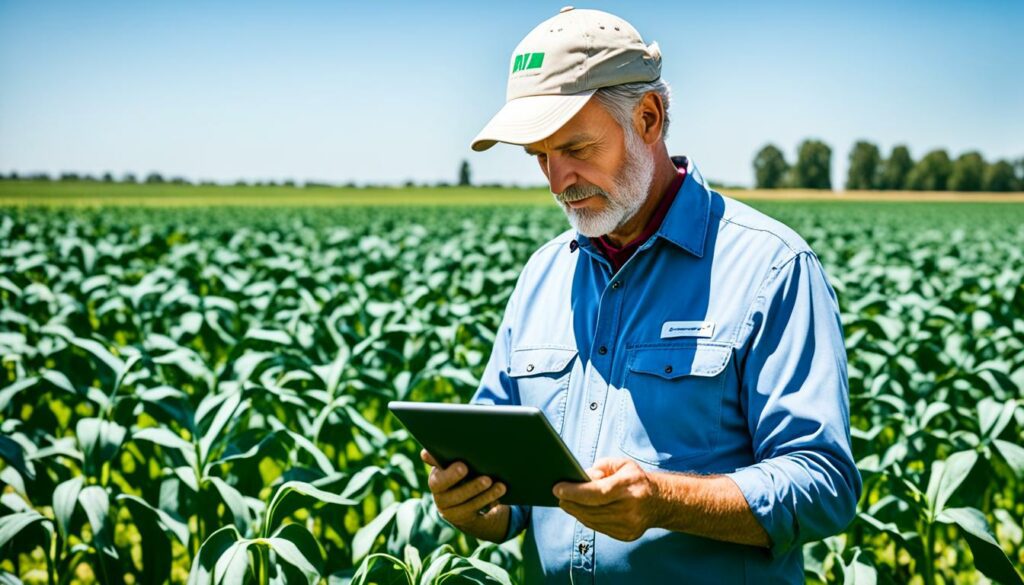
Adopting precision farming is getting a boost from big funds from federal agencies. Both the USDA and NSF have put in nearly $200 million for this effort. Yet, only a bit over a quarter of U.S. farms use these technologies due to costs, data issues, and differing standards.
Using these new tools leads to better crop quality and less spending on materials. For instance, VRT makes it possible to apply fertilizers with more accuracy, cutting herbicide needs by 9%. Also, data from satellites and soil sensors allow quick changes, keeping crops healthy and resources well-used.
Here’s a table showing the good effects of precision agri-tech on the environment and resources:
| Metric | Improvement |
|---|---|
| Crop Production | 4% Increase |
| Fossil Fuel Usage | 100 Million Fewer Gallons |
| Water Consumption | 21% Reduction |
| Herbicide Use | 30 Million Fewer Pounds |
Getting into precision agriculture means knowing about new technologies like self-driving machines and IoT. Continuous education is crucial for farmers to make the most of these advances. This will make farming not just more efficient but also better for the planet.
Precision agriculture shows its worth through real-life examples. Bob Deck manages a vineyard over 7,000 acres, creating up to 4 million cases of wine a year. He spent around $22,000 on precision tools. This included money for software and a GPS unit. By using such technology, he’s achieved great success, proving the power of precision farming. Remote sensing, at just $1 per acre, adds to the efficiency.
Shippy Vineyards in the Salinas Valley, overseen by Perry James, covers 6,000 acres. Perry installed six weather stations. They observe the climate every 15 seconds and share updates with farm supervisors every 15 minutes. This precision method guards the vines against frost and ensures the best use of water through up-to-the-minute weather data.
International studies show the wide-ranging benefits of precision farming:
Successful examples in this field include John Deere’s work, the Climate Corporation’s tech, and AeroFarms’ innovative farming methods.
In Australia, VRI led to a 20% increase in yields and saved 30% on water. The American Midwest cut fertilizer use by 15% while keeping yields steady. In Europe, precision farming lowered pesticide use by 30% in some areas.
In Kenya, an AI app saw farmers earning 25% more by using data smartly. South American farmer groups use drones and satellites to boost their farms. These cases clearly show how precision farming can bring big improvements and successes in the field.
Moving towards precision agriculture is more than just modernisation. It’s a big step into a sustainable, profitable future for farming. This method uses GPS, drones, and satellite images to improve how we use resources.
It provides instant data about crops and soil, allowing for smarter farming. This can lead to better crop yields by managing each field area differently.
Smart farming offers more than just increased productivity. It cuts costs on water, fertilisers, and pesticides, making farming more profitable. Also, it lowers the industry’s impact on the environment by using resources more wisely and reducing pollution.
Precision agriculture is the future of farming. It tackles both economic and environmental issues. Even though it needs a big initial investment, its benefits in efficiency and sustainability are clear. Making these technologies more widely available is crucial, particularly in places with limited resources. In the end, using precision agriculture can lead to a profitable and eco-friendly agricultural sector.
Precision agriculture is a modern farming approach. It uses technology like GPS to manage crops better. This way, farmers can use their land, water, and energy more wisely.
Mobile tech makes precision agriculture more efficient. It lets farmers check their crops instantly. They can also track weather, control machines, and share info with other farmers easily.
There are several trends pushing precision farming forward. This includes IoT, where devices ‘talk’ to each other, and machines doing tasks on their own. These trends help farmers work smarter and save resources.
Precision farming brings many benefits. It makes farms more productive and eco-friendly. It helps farmers save time and money, and grow better crops. Overall, it leads to more sustainable and profitable farming.
Precision farming isn’t without its challenges. Digging into too much data, getting all systems to work together, and the high cost at startup can be tough. Some farmers might find these hurdles hard to overcome.
Precision farming helps protect the environment. It does this by saving water and reducing the use of chemicals. It also supports efforts that lock carbon in the ground. These steps make farming less harmful to nature.
High-tech sensors and drones are very important. They take images of the fields and measure soil and plant health. With this data, farmers can make the right choices to grow better, using less.
Precision farming is good for business. It cuts costs and boosts crop production. This means more money for farmers over time.
By analysing lots of data, precision farming can pinpoint exactly what crops need. This leads to better farming practices. As a result, it increases productivity across the farm.
The future of farming lies in even more advanced technology. This includes machines that can work on their own and more internet-connected devices. These will help farmers do their jobs better, use resources wisely, and predict future needs.
Adding precision to farming means picking the right tech for the farm. It should work with what’s already there. Then, farmers can slowly start using it more and more, making their farming more efficient over time.
Many farms have shown that precision farming works. They use technology to farm smarter. This has led to better farming all around, from growing more food to protecting the land and making more money.